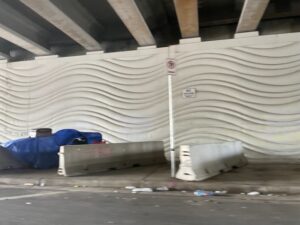 BY DOMINICK BOUZA
BY DOMINICK BOUZA
On Nov. 19, 2022, I was video recording the encampment under the I-35W bridge on 31st Street while driving. Twelve tents or so lined both sidewalks. Lacking water or any amenity, the wind howling trough the underpass, this encampment was destined for disaster should a kerosene heater go awry. The city of Minneapolis removed the tents before the deep freeze set in, erecting concrete barriers every four feet, diagonal to the sidewalk. “Windbreakers!” was my thought.
On May 30, 2023, I recorded under the same bridge as a new encampment began to gather. Tarps hang over two concrete barriers to house some residents. The activity here mirrors the worst elements of a very public encampment.
Attracting more homeless people, others have taken to the boulevard (as has been done many times before in our city). Tents, tarps and makeshift structures stand just beyond the front yards of homes. A mere two weeks after staking the property, garbage is mounting, and other health hazards are becoming apparent.
There’s a guy holding up a sign around the corner on 2nd Avenue. My experience has been that he will collect enough donations – from the outstretched hands of guilt – to purchase a large bottle of vodka. That bottle is shared within a subgroup of six or seven within the encampment, who empty the bottle. Inebriation of this sort leads to many other challenges the homeless face.
Pills requiring micro-precision to manufacture, replacing a legal narcotic with fentanyl, may initiate a deadly overdose. Heroin is just as accessible, with the same risks. All of the above mask mental health issues plaguing many of the campers.
Police support outreach workers, making contact with squatters. Therein lies the rub. The cops respond to assaults and effect arrests on abusers. They respond to overdoses with a shot of Narcan, bringing a young life back from the brink. They respond to thefts, disturbances and calls by homesteading residents. 911 dispatchers send well-trained mental health crisis responders (with no police support) to de-escalate a despondent, most likely formerly abused, wayward soul.
The rub? Case managers, experienced in homeless outreach and service support, offer rides or directions to day services. Police refer non-offense (or minor offense) responses regarding homeless people to outreach workers. Employment opportunities abound. Educators are ready and eager. Food shelves are stretched, volunteers supporting the food crisis that began around 2020. They still serve all who show. The only amenity the homeless outreach case managers can’t offer the homeless campers is immediate housing or shelter.
The ongoing condition, since my entry into working for the homeless in 2000, is a decrease in the number of available shelter beds in Minneapolis. Instead of hidden encampments by the Mississippi River, light rail stations house the homeless in large numbers. From St. Paul to Bloomington’s Mall of America, the homeless sleep in brightly lit (terrible for circadian rhythms) waiting rooms. They are rousted at 2 a.m. every night as the station closes for an hour.
“Micro homes” is an old idea seeing support by the city. Micro homes are basically a room the size of a bedroom with multiple housing amenities. The enclosed units are housed inside a warehouse. The leadership of this new attempt at short-term shelter in Minneapolis is having success with residents taking ownership of their living area.
If we address homelessness as a community issue, much like Finland has done, we would see a significant reduction in the homeless sleeping in unhealthy environments or out in the elements of Minnesota.
Can’t we find an architect who would design the property for a personal tax deduction from the government? Can’t we find a builder to do the same thing? I know some union folks who would jump at the idea. Couldn’t we have a beautiful sign, mural, or something the city wants to announce “Minneapolis” on that empty property just off I-35W entering downtown from the north, adorning a unique structure? What about this type of responsible shelter on top of retail stores, maybe even a Walmart, at Lake Street and Nicollet?
A responsible funding program could be sought from the state senator that I sent the original video to last fall, in a fit of despair. Since then, certainly after reading the 2023 omnibus bill establishing about three quarters of a billion dollars to homelessness housing and programming already, I realized that my senator is there to give nonprofits money, not provide the solution to homelessness. Homelessness is our problem.
Dominick Bouza served the homeless through housing programs supported by Catholic Charities, The Salvation Army and Project for Pride in Living (2000-2016). He currently serves (voluntarily) as a homeless advocate on the Minneapolis police chief’s citizens’ advisory council.
























The micro homes idea sounds good and very reasonable in cost. They can be put into empty warehouses or put on top of large buildings like Walmart, etc.
Is someone working on this?
This sounds like a very good option. There seems always to be enough money available for whatever the ‘people in charge’ want to use it for, so I know this is not a money issue. We need to help our homeless people live a safe and healthy life. Homelessness is NOT a choice for the majority of people. The problem is either financial or mental health issues or both. I know from experience that our government has been cutting back on funding for the less fortunate. Homelessness gets worse every year. It’s time to do something about.